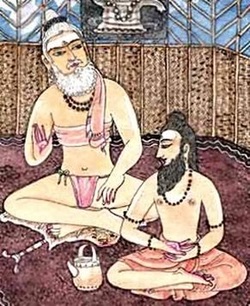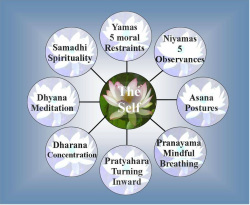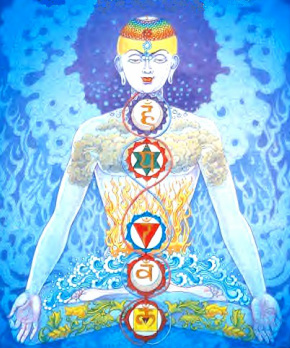
What is Yoga?
The word "yoga" comes from the Sanskrit root "yuj", which means "to join" or "to yoke". Yoga has many paths, and when we integrate the different strands , we can harmonize and evolve the whole personality.
What is often referred to as "yoga" in the Western world today is Hatha yoga which is the variation of raja yoga. Yoga is ,however , an ancient art that harmoniously integrates all aspects of the individual - body with mind and mind with soul. In the Yoga Sutra, compiled between 100 BCE and 500 CE, Patanjali encapsulates the essence of Yoga in four words:
योगश्चित्तवृत्तिनिरोधः ॥२॥
yogaś-citta-vṛtti-nirodhaḥ ||2||
Yoga stills the natural turbulence of the mind.
The word "yoga" comes from the Sanskrit root "yuj", which means "to join" or "to yoke". Yoga has many paths, and when we integrate the different strands , we can harmonize and evolve the whole personality.
What is often referred to as "yoga" in the Western world today is Hatha yoga which is the variation of raja yoga. Yoga is ,however , an ancient art that harmoniously integrates all aspects of the individual - body with mind and mind with soul. In the Yoga Sutra, compiled between 100 BCE and 500 CE, Patanjali encapsulates the essence of Yoga in four words:
योगश्चित्तवृत्तिनिरोधः ॥२॥
yogaś-citta-vṛtti-nirodhaḥ ||2||
Yoga stills the natural turbulence of the mind.

Patanjali explains that through the 8 limbed path (ashtanga ), dedicated practice and the cultivation of detachment, we will stop identifying with the thoughts, feelings, and sensations that can cause us so much emotional pain—and we will open to an experience of our true self .
The Eight Limbed Path / Ashtanga Yoga
1. Yama (self-restraints, social observances)
2. Niyama (personal, inner disciplines)
3. Asana (postures)
4. Pranayama (pranic breathing techniques)
5. Pratyahara (sensory withdrawal)
6. Dharana (concentration or one-pointedness)
7. Dhyana (meditation)
8. Samadhi (absorption, self-realization)
In the West, what is called "yoga" are the asanas, the postures which are but one of the limbs of Yoga laid out by Patanjali. The core practice of yoga is meditation and the asanas are done, traditionally so that the body is comfortable for pranayama and then meditation. The body is a vessel and what the asanas do is free energy blockages allowing for the smooth flow of prana (life force) through the channels of our nervous systems so that we experience greater comfort in our physical lives.
The Eight Limbed Path / Ashtanga Yoga
1. Yama (self-restraints, social observances)
2. Niyama (personal, inner disciplines)
3. Asana (postures)
4. Pranayama (pranic breathing techniques)
5. Pratyahara (sensory withdrawal)
6. Dharana (concentration or one-pointedness)
7. Dhyana (meditation)
8. Samadhi (absorption, self-realization)
In the West, what is called "yoga" are the asanas, the postures which are but one of the limbs of Yoga laid out by Patanjali. The core practice of yoga is meditation and the asanas are done, traditionally so that the body is comfortable for pranayama and then meditation. The body is a vessel and what the asanas do is free energy blockages allowing for the smooth flow of prana (life force) through the channels of our nervous systems so that we experience greater comfort in our physical lives.
Benefits of Yoga
Yoga has innumerable benefits and here are just a few to consider:
Physical Mental & Emotional Spiritual
|
|
|


